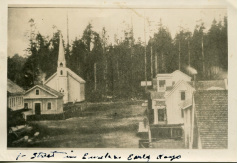Early Settlement

The Spanish were the first Europeans to explore the Humboldt coast, but they never settled here. Around 1580, they named Cape Mendocino, after the Viceroy of New Spain. On the Feast of the Trinity in 1775, two Spanish ships anchored in a bay they named Trinidad. They took on fresh water, traded with Yurok Indians and erected a large wooden cross on Trinidad Head. In the years following, Russian and American fur traders visited the coast. Humboldt Bay, entered briefly by Russians in 1804, was generally overlooked because the sand bar off the entrance and the high bluff beyond gave the appearance of unbroken dunes and surf.
In 1848, discovery of gold in the trinity mountains changed history The difficulty of reaching the gold fields from the Sacramento Valley prompted a party of explorers, led by Josiah Gregg to look westward for a route to the coast. After a long difficult trip, a quarrel on a riverbank led to naming the Mad River. On Dec. 20, 1849, the Gregg party re-discovered Humboldt Bay and made friendly contact with local Wiyot Indians.
In 1848, discovery of gold in the trinity mountains changed history The difficulty of reaching the gold fields from the Sacramento Valley prompted a party of explorers, led by Josiah Gregg to look westward for a route to the coast. After a long difficult trip, a quarrel on a riverbank led to naming the Mad River. On Dec. 20, 1849, the Gregg party re-discovered Humboldt Bay and made friendly contact with local Wiyot Indians.
